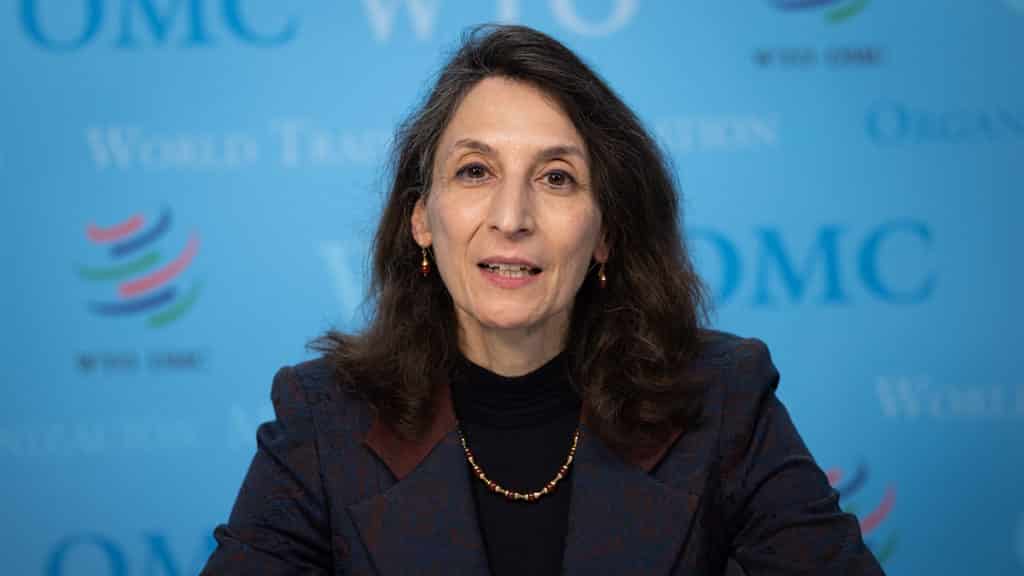“El comercio desempeña un importante papel en la adaptación al cambio climático y su mitigación” — DGA Ellard

El 26 de octubre, la Directora General Adjunta Angela Ellard destacó la función del comercio internacional y de la OMC en la ayuda a luchar contra el cambio climático. Hablando en nombre de la Directora General Ngozi Okonjo-Iweala en el evento “Líderes Mundiales para la Acción Climática”, organizado por la Camara de Comercio Internacional del Reino Unido, señaló que, si bien la OMC no es el foro adecuado para establecer objetivos globales de política climática, desempeña una función importante, ya que sus normas rigen los impuestos, los aranceles, las subvenciones, las medidas de reglamentación y otros instrumentos pertinentes para la aplicación de políticas climáticas. Her remarks are below.
(de momento sólo en inglés)
Good afternoon. Thank you for inviting me to this important event, which is particularly timely in the lead up to COP 26.
Let me start by restating the obvious: climate change, one of the most pressing challenges of our time, must be tackled to save the planet. Scientists tell us that it is still possible to get global warming under control, but only if unprecedented action is taken now. The international community must make every effort to agree on the course of action to avoid a climate disaster.
The WTO is not the place to establish global climate policy and how goals will be reached. However, the WTO plays an important role because its rules govern taxes, tariffs, subsides, regulatory measures, and other instruments that are relevant for implementing climate policies.
Therefore, today, I will talk about how international trade — and the WTO as the guardian of multilateral trade rules — can help achieve climate goals. I have three main messages.
My first message is that international trade plays an important role in combatting and adapting to climate change.
When speaking about trade, it is tempting to think only that trade contributes to climate change through emissions caused by the production and transportation of goods. But this view is incomplete because trade is also a central part of the solution, enhancing both adaptation and mitigation efforts.
To transition to a low-carbon economy, countries need affordable access to advanced technologies. And open trade plays a critical role in providing such access. Lowering barriers to trade in environmental goods and services helps facilitate transfer and deployment of climate change mitigation and adaptation technologies.
While an average tariff on environmental goods is relatively low, particularly in developed economies, some environmental goods are subject to very high tariffs. The WTO can bring these tariffs down through an Environmental Goods Agreement.
In addition, many such goods are subject to non-tariff barriers — for example, local content requirements — and eliminating them should be a top priority.
Furthermore, installation and operation of clean technology is often complex and requires specific user skills that can be difficult to source domestically. So, removing barriers on environmental services, such as environmental consulting and engineering, can help reduce costs of projects that lower emissions.
And such access is particularly important for developing countries. Think about it: 13% of the world’s population doesn’t have access to a stable electricity supply. Households that are off-grid benefit from access to electricity through solar power, and the environment benefits because this energy is renewable.
Let’s look at agriculture — the sector likely to be affected most by climate change. Open trade is a powerful adaptation tool for this sector.
Rising temperatures decrease productivity for crops and livestock. Research suggests that productivity in this sector is 21% lower today than without climate change. At the same time, by 2050, the world’s population will reach 9 billion, and food production must increase by 70% to feed everyone.
Farmers can adjust to rising temperatures and meet increasing demand for food by improving yields through low-carbon technologies, innovative approaches to combat weeds, and switching to varieties of seeds better fit for higher temperatures. All such innovations have to move freely between countries.
Trade is increasingly affected by extreme weather-related shocks, such as storms, floods, and droughts, which can severely disrupt supply chains and spread the impact beyond the area affected. But trade can also support resilience and recovery by delivering food, medications, and other vital products to places affected by natural disasters.
And, finally, free movement of environmental goods and services also results in economic diversification and job creation, particularly in services. For example, the rooftop installation cost of photovoltaic modules accounts for approximately 60% of the total cost. Services jobs related to renewables are often supplied locally and carried out by women. A growing number of jobs, especially in Africa, are being created in off-grid decentralized renewables, which also boosts employment in other sectors such as agro‑processing, health care, communications, and local commerce.
So, that’s my first point: trade is necessary to combat climate change.
My second message is that there is an urgent need for coordination and collaboration in trade and climate change, particularly in carbon pricing. The WTO and other international organisations should work together to support governments in taking effective trade and climate action.
Countries are moving at different speeds towards decarbonising their economies, resulting in significant disparity in policy approaches. While carbon pricing is a valuable instrument, there are almost 70 different carbon pricing schemes globally, and they cover less than 22% of total emissions. Carbon prices vary widely, from less than US$ 1 per ton of CO2 to more than US$ 130.
Some developed countries are considering so-called “border tax adjustment measures,” intended to ensure that foreign competitors are subject to the same carbon costs as domestic producers. Developing countries fear that border adjustment is a pretext for protectionism aimed at their exports, when they are not the core problem because their historic emissions are low. And high carbon sectors in the developed and developing world fear discrimination.
The proliferation of divergent carbon pricing approaches will generate significant trade frictions, as well as create unpredictability for businesses seeking to decarbonize. These concerns could weaken the effectiveness of global efforts to mitigate climate change.
The optimal solution would be a global carbon price aligned with the Paris Agreement, but we are not there yet. In the absence of such a mechanism, international organisations, such as the WTO, the World Bank, and others, must work together on common approaches to carbon pricing, ensuring that measures are not adopted in a discriminatory manner and that the needs of developing countries are addressed to enable a just transition.
And this brings me to my third point: how can the WTO help ensure the mutual supportiveness of trade and climate change policies?
When talking about climate, one may not immediately think about the WTO.
But the WTO provides a unique forum for Members to explain their efforts to mitigate and adapt to climate change and address potential misunderstandings. Our Environment Database shows that governments have adopted a broad range of trade-related climate measures — over 4500 since 2009, from direct taxes to regulatory approaches — and discussed their trade implications in various WTO fora, such as our Committee on Trade and Environment. And Members may decide that they want to adopt new rules to give governments more flexibility to adapt.
The WTO has established several transparency mechanisms such as notification requirements and periodic trade policy reviews to inform about climate-related trade measures. Our work to facilitate supply chains for vaccines and therapeutics for the COVID pandemic can serve as a blueprint for work with the private sector on sustainable and resilient supply chains.
Finally, the WTO’s Aid for Trade initiative can help mobilize investments for critical infrastructure necessary for developing countries’ green transformation. One quarter of our Aid for Trade disbursements — USD 65 billion — was allocated to projects with a climate objective. And 40% of that sum went to renewable power generation, distribution, and energy conservation, while more than quarter went towards climate-friendly and climate-resilient infrastructure. We must scale up the green component of Aid for Trade by developing synergies with climate financing programs.
Let me conclude by reiterating we need all hands on deck to face the global challenge of climate change. With the right policies, trade can be a powerful engine of the net‑zero transition. COP 26 and the WTO’s 12th Ministerial conference present us with an opportunity to take a leap forward to make trade a force for climate action. Let’s not waste it. Thank you.
















